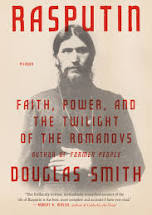Rasputin: Faith, Power, and the Twilight of the Romanovs
There are so many tales about Rasputin -- the Mad Monk who cast his spell over the last Tsarina of Russia and was a cause of the downfall of the Romanovs. He had a strange power to relieve the hemophilia symptoms of the Tsarevich Alexei, heir to the throne; he had perverse and unquenchable sexual appetites; he was the very personification of evil.
Except
that most of what we think we know about Rasputin is not true. In this biography by Douglas Smith, 2016, a clearer
and more fascinating life of Rasputin is presented. Smith is an award-winning
historian, and earlier had worked for the US State Department in the former
Soviet Union and as a Russian translator and affairs analyst for Radio Free
Europe.
In
the introduction to the book Smith writes that he was determined to search out
the facts of Rasputin’s life by conducting extensive research, which he
claims led him to seven countries, “from Siberia and Russia, across Europe, to
Britain and finally the United States.” In addition, he was able to gain access
to previously unavailable archives and records and so reveals a lot of
information that had not been made public before. But he writes:
“A
curious thing happened, however, as I was following the footsteps of this
elusive, real Rasputin. The deeper I went into my research, the more convinced
I became that one of the most important facts
about Rasputin, the thing that made him such an extraordinary and powerful
figure, was less what he was doing
and more what everyone thought he was
doing.”
And
later in the introduction:
“To
separate Rasputin from his mythology, I came to realize, was to completely
misunderstand him. There is no Rasputin without the stories about Rasputin. And
so I have been diligent in searching out all these stories, be it those
whispered among the courtiers in the Romanovs’ palaces, the salacious chatter
wafting through the aristocratic salons of St. Petersburg, the titillating reports
from the boulevard press, or the pornographic jokes exchanged among Russian
merchants and soldiers. By following the talk about Rasputin I have been able
to reconstruct how the myth of Rasputin was created, by whom, and why.”
One
of the documents Smith was able to find is an interview in a Russian newspaper with
the autopsy surgeon who carried out the autopsy on Rasputin. (The autopsy
report itself disappeared from the archive years after the end of the
Romanovs.) He revealed that Rasputin had been shot three times, and the third
shot – directly to the head – is the one that killed him. There was no poison
found in the body, no water in the lungs, and various wounds and disfigurations
were caused after death from being tossed about in the icy river. So the myth
surrounding the long, drawn-out death of Rasputin is false.
It
is this unraveling of the truth from commonly believed fiction that makes this
book so fascinating. In addition, with 682 pages (not counting the maps, 102 photos,
bibliography, notes, and index), there is plenty of information about Rasputin’s
background, the customs and lifestyle where he grew up, information about
life and politics at court and in Russia at that time, and about both Nicholas and Alexandra,
the Tsar and Tsarina.
The
book not only provides extensive information, but is written extremely well and
reads like an engrossing novel. For anyone interested in Grigory Yefimovich
Rasputin, or the last Russian Tsar and Tsarina, or Russian history, this book
is essential. Even for those who have never heard of Rasputin, this book is a great read and an
excellent example of how truth is stranger than fiction.

Comments
Post a Comment